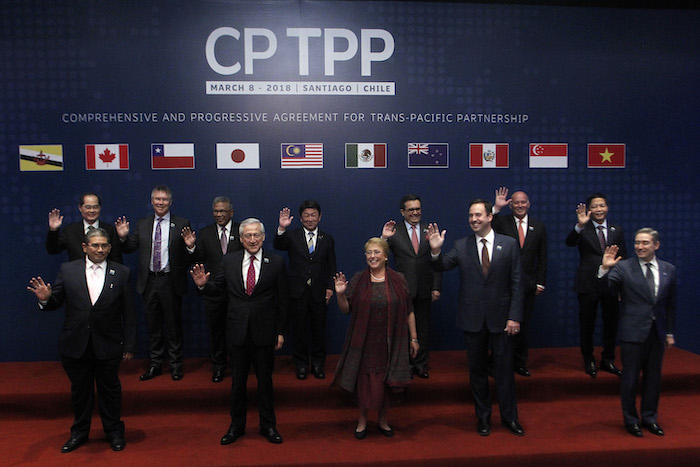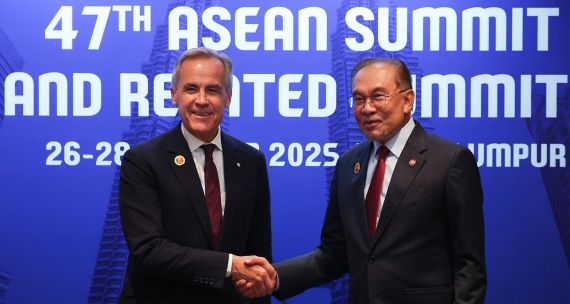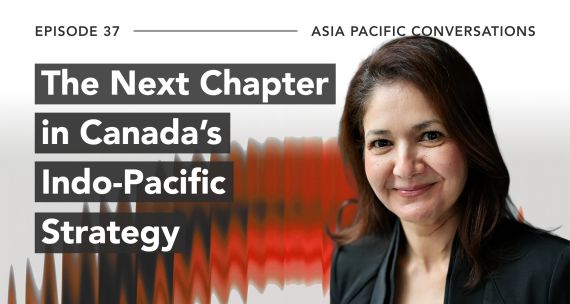The free trade agreement now known as the Comprehensive and Progressive Agreement for Trans-Pacific Partnership (CPTPP) was, from its inception, designed to expand through an accession clause. In fact, it has already done so – from the original three members to four, then expanding to seven to nine to 11 to 12, before dropping back to 11 members following US withdrawal. It is currently growing again – to 12 – with a long list of applicant members waiting in a queue.
The original process of gaining new members largely took place under a set of informal practices:
- Asking the potential member to hold a set of meetings with current members to try to resolve any “bilateral irritants” that might impede future deliberations in the group.
- Asking the potential member not seek to reopen rules and texts that were considered to be closed.
- Admitting new applicants through a collective decision by active members.
Members also agreed that the final agreement should be high quality, high standard, and comprehensive. It would not include special and differential treatment for developing country members (beyond some limited time-bound extensions for implementation of some provisions). Prospective members were not allowed to join as observers but had to be either in or out of the negotiations.
Members also agreed that the final document would apply to all participants with limited scope for exceptions. Any member-specific exceptions were largely to be managed through a very modest number of permitted side letters between members. These side letters included, for example, clarity on the application of past trade arrangement provisions or exemptions from certain provisions for side letter signatories.
The pros and cons of formalizing the process
Many of these informal processes have since been captured by the accession rules contained in the final CPTPP legal texts (Article 30.4) and revised by members of the CPTPP Commission in 2019 (Annex to CPTPP/COM/2019/D002).
The provisions for accession, while growing, are still limited, albeit with ample scope for interpretation. For example, the CPTPP accession document (section 2.1) states that: “The Comprehensive and Progressive Agreement for Trans-Pacific Partnership Commission (Commission) will determine, in a manner consistent with Article 27.3 (Decision Making) and Article 27.4 (Rules of Procedure of the Commission), whether to commence the accession process with the aspirant economy within a reasonable period of time after the date on which the aspirant economy made the Accession Request.” Whether members have acted in a “manner consistent with” Article 27 requirements is unclear, as is the meaning of the term “within a reasonable period of time.”
In short, while CPTPP members have taken steps to further refine and clarify the conditions and procedures attached to entry to the agreement, there are still wide gaps.

This matters because CPTPP members are currently grappling with a long and challenging queue of aspirant applicants including China, Costa Rica, Taiwan, Ukraine, and Uruguay. Admitting new members will always be difficult, but the diverse range of countries that have expressed an interest in joining the CPTPP and the specific issues that their membership might bring to the group are varied.
Some aspirant members have done substantial work preparing for negotiations, with extensive consultations and gap analyses already completed. Others are much less prepared. CPTPP members have begun trying to level this playing field for applicants by requesting aspirant members fill out a formal membership application and respond to questions from current members.
Some potential members present specific challenges vis-à-vis existing requirements of the CPTPP, such as in sector-specific areas like agriculture or a willingness to uphold existing rules and obligations around such issues as digital trade or state-owned enterprises (SOEs). Other potential members may raise political or security concerns among some existing members.
In short, the diversity of current applicants and the range of issues they bring to the table represent a tough nut to crack for existing members. Until now, CPTPP members could argue that the accession processes needed to be slowed down pending entry into force for all existing members or clarified and refined based on the evolving experiences recorded through the accession of the United Kingdom, the first new applicant to proceed through accession since ratification of the agreement in December 2018. But with all 11 original signatories now ‘live’ and the U.K.’s membership undergoing domestic-level ratifications with a final entry into force date looming, these justifications for delay in processing additional membership requests are wearing thin.
An attempt at smoothing the way: the ‘Wellington Principles’
As the 2023 CPTPP Commission Chair, New Zealand articulated three “Wellington Principles” to govern accession. These principles state that aspirant members:
- Should be prepared to undertake the high quality, high standards embedded in the CPTPP.
- Have demonstrated success in upholding the trade commitments of past agreements.
- Are likely to achieve consensus among current members for the creation of a Working Party.
These are, frankly, not terribly helpful principles and leave the CPTPP unlikely to manage the accessions of more than one or two potential members. Surely all aspirant members will say that they are prepared to meet the high standards of the agreement. No applicant to any organization pledges up front to duck commitments. Members will have a hard time justifying a rejection decision based on whether they think the member might or might not uphold standards in the future. At a minimum, it is possible to imagine a member very determined today to follow CPTPP obligations, but no one can guarantee that future governments will have the same passion for the agreement.
A determination of the success of applicants in managing past agreement practices is in the eye of the beholder. Such a review also opens up the group to careful scrutiny of their own adherence to existing commitments. Given the number of CPTPP provisions that have not been implemented as intended by current members, this review could be quite uncomfortable. For example, the CPTPP is currently undergoing a review process mandated in the agreement for “year three” in 2024. Under any reasonable math standards, 2024 is more than three years from the start of an agreement that came into force in 2018. Such deviations in implementation – like failing to hold a scheduled overall review, update online information, or skipping required meetings to review specific chapters or provisions – can be found all over the document and in the domestic application of CPTPP provisions for every current CPTPP member.
The Wellington Principles do not really create a stronger foundation for making decisions about aspirant members. What is needed is a much more flexible and creative approach to managing the processes of decision-making on membership while still honouring the existing obligations for accession.
Lingering challenges to an accessible and equitable process
The CPTPP needs to expand, as more members create more benefits for the group. But it also needs to select members that will ultimately contribute to better outcomes and not create substantial obstacles to the success of the agreement.
There remain important practical considerations attached to CPTPP accession. First, the process is resource intensive, as the recent U.K. negotiations over two years demonstrated. Getting members together, particularly in the absence of a Secretariat with permanent staff, means that every existing CPTPP member must staff up for negotiations, plan and budget for extensive travel, manage online discussions across a wide range of time zones, and commit substantial financial and staff resources to negotiations. The accession process simply cannot be bespoke, with negotiations underway for each of the six or more members in the queue, but must be bundled together in some way.
Second, although there have been limited discussions about what it means to act on applications for membership in a “reasonable period of time,” some aspirants have been waiting for years already. And third, deciding to open a formal Working Party to manage an accession has become a political challenge, as many of the current aspirant members come with potential baggage of one sort or another. This leads current members to a default position of accepting no one, or potentially a very limited number of applicants, rather than taking politically and economically risky decisions to formally launch Working Parties.
Recommendation: Introduce a CPTPP Dialogue Group
To solve several of these interlocking problems at once, CPTPP members should invite all aspirant members that have successfully submitted an application form (and potentially responded to at least one round of questions from current members to the information on the application form) to join a CPTPP Dialogue Group. The Dialogue Group would launch on a specific date and would not be opened for additional participants for a set period of time (perhaps 1-2 years). This should ensure that potential members take the application materials seriously and that any ‘fence-sitters’ act immediately or miss a critical window of opportunity to join the CPTPP.
This Dialogue Group would meet with all qualified aspirant and current members for the first session. The first round of Dialogue Group meetings would focus on ensuring that all participants are familiar with the process, have an opportunity to discuss the state of existing commitments, understand the planned process, and are familiar with any known deadlines.
Future Dialogue Group meetings would be held on a regular basis, with Dialogue Group members asked to participate in sector-specific meetings. For example, ‘Market Access for Goods’ could meet on Monday with Dialogue Group Party A, on Tuesday with Dialogue Group Party B, and so on. This would help ensure that current members can deploy resources strategically and send, for instance, all goods negotiators to just one set of meetings. Having a set meeting schedule also allows better budgeting than an ad-hoc process.
The Dialogue Group would feed progress reports from the sectoral negotiations — such as goods, services/investment, SOEs, and government procurement – to the CPTPP Commission to allow the Commission to decide on whether aspirant candidates should remain part of the Dialogue Group process, be encouraged to suspend or delay talks with a party if negotiations are not proving fruitful, or elevate an aspirant from the Dialogue Group to a Working Party.
The transition to a Working Party, as required under current CPTPP rules, could take place at any point during the Dialogue Group negotiations, including at the very end.
Simply because all aspirants start the Dialogue Group together does not mean that members would need to conclude talks at the same time. In fact, because the opening Dialogue Group meetings would include a wide range of aspirant members at different stages of preparation, it is highly unlikely that all would be able to conclude simultaneously. The Commission, for its part, should not wait until all parties are equally ready to announce any expansion in CPTPP membership.
Dialogue Group members struggling to manage commitments could be given additional support and capacity building to help them meet any specific challenges as part of the process of preparing potential members to participate in high-quality, high-standard agreements.
Holding a Dialogue Group as a mechanism for managing accession may also have one additional benefit. While the informal norms prohibit changing any existing texts or commitments as part of the accession process, some of the CPTPP rules could use updates or adjustments. The CPTPP was envisioned as a “living agreement” that would not remain in amber. In practice, however, it can be difficult to manage a process of adjustments on an ad-hoc basis or even by using committees. The Dialogue Group could provide a way to socialize current and potential members around possible alterations to the existing CPTPP agreement and make recommendations to the Commission on changes.
In any case, by bundling together all aspirant members into a Dialogue Group, CPTPP members would avoid making difficult choices in the absence of information about how aspiring new members might actually behave within the CPTPP negotiations. It is not until aspirant member schedules – for things like tariff commitments and tariff rate quotas for trade in goods, lists of reservations for services and investment, or lists of covered and excluded state-owned entities – are exchanged between parties that participants are able to more effectively assess the likelihood of meeting the high standards of the agreement. Managing accessions as part of a Dialogue Group exercise would limit the resources needed to successfully conclude talks and significantly shorten the time needed to get expansion underway.





